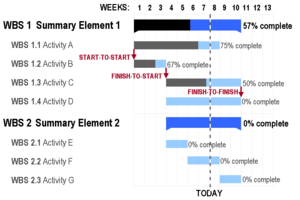User:Janet majors/henderson chart
| This is not a Wikipedia article: It is an individual user's work-in-progress page, and may be incomplete and/or unreliable. For guidance on developing this draft, see Wikipedia:So you made a userspace draft. Find sources: Google (books · news · scholar · free images · WP refs) · FENS · JSTOR · TWL |

A Henderson chart is a type of chart that illustrates resource assignments. Henderson charts illustrate the location and/or allocation of resources, human or otherwise. Shapes are used to represent resources and locations. Resource capabilities are distinguished by colors. Task status also.
Although now regarded as a sofisticated charting technique, Henderson charts were used by many Generals during World War II to control the location of resources like submarines and army divisions and their missions.
Historical development[edit]
The first known tool of this type was reportedly developed in 1925 by Robert Nicholas Henderson, who called it a locusgram. After his death Henderson did not publish his chart until 1931, however.
In the 1990s, personal computers allowed for widespread creation of complex and elaborate Henderson charts. The first desktop applications were intended mainly for project managers and project schedulers. With the advent of the internet and increased collaboration over networks at the end of the 1990s, Gantt charts became a common feature of web-based applications, including collaborative groupware.
Advantages and limitations[edit]
| This section may require cleanup to meet Wikipedia's quality standards. No cleanup reason has been specified. Please help improve this section if you can; the talk page may contain suggestions. |
Gantt charts have become a common technique for representing the phases and activities of a project work breakdown structure (WBS), so they can be understood by a wide audience all over the world.
A common error made by those who equate Gantt chart design with project design is that they attempt to define the project work breakdown structure at the same time that they define schedule activities. This practice makes it very difficult to follow the 100% Rule. Instead the WBS should be fully defined to follow the 100% Rule, then the project schedule can be designed. [1]
Although a Gantt chart is useful and valuable for small projects that fit on a single sheet or screen, they can become quite unwieldy for projects with more than about 30 activities. Larger Gantt charts may not be suitable for most computer displays. A related criticism is that Gantt charts communicate relatively little information per unit area of display. That is, projects are often considerably more complex than can be communicated effectively with a Gantt chart.
Gantt charts only represent part of the triple constraints (cost, time and scope) of projects, because they focus primarily on schedule management. Moreover, Gantt charts do not represent the size of a project or the relative size of work elements, therefore the magnitude of a behind-schedule condition is easily miscommunicated. If two projects are the same number of days behind schedule, the larger project has a larger impact on resource utilization, yet the Gantt does not represent this difference.
Although project management software can show schedule dependencies as lines between activities, displaying a large number of dependencies may result in a cluttered or unreadable chart.
Because the horizontal bars of a Gantt chart have a fixed height, they can misrepresent the time-phased workload (resource requirements) of a project, which may cause confusion especially in large projects. In the example shown in this article, Activities E and G appear to be the same size, but in reality they may be orders of magnitude different. A related criticism is that all activities of a Gantt chart show planned workload as constant. In practice, many activities (especially summary elements) have front-loaded or back-loaded work plans, so a Gantt chart with percent-complete shading may actually miscommunicate the true schedule performance status.
Example[edit]
In the following example there are seven tasks, labeled A through G. Some tasks can be done concurrently (A and B) while others cannot be done until their predecessor task is complete (C cannot begin until A is complete). Additionally, each task has three time estimates: the optimistic time estimate (O), the most likely or normal time estimate (M), and the pessimistic time estimate (P). The expected time (TE) is computed using the formula (O + 4M + P) ÷ 6.
| Activity | Predecessor | Time estimates | Expected time | ||
|---|---|---|---|---|---|
| Opt. (O) | Normal (M) | Pess. (P) | |||
| A | — | 2 | 4 | 6 | 4.00 |
| B | — | 3 | 5 | 9 | 5.33 |
| C | A | 4 | 5 | 7 | 5.17 |
| D | A | 4 | 6 | 10 | 6.33 |
| E | B, C | 4 | 5 | 7 | 5.17 |
| F | D | 3 | 4 | 8 | 4.50 |
| G | E | 3 | 5 | 8 | 5.17 |
Once this step is complete, one can draw a Gantt chart or a network diagram.
See also[edit]
- Critical path method
- List of project management software
- Program Evaluation and Review Technique (PERT)
- Event chain diagram
References[edit]
- ^ Project Management Institute (2003). A Guide To The Project Management Body Of Knowledge (3rd ed. ed.). Project Management Institute. ISBN 1-930699-45-X.
External links[edit]
- Long-running discussion regarding limitations of the Gantt chart format, and alternatives, on Edward Tufte's website

